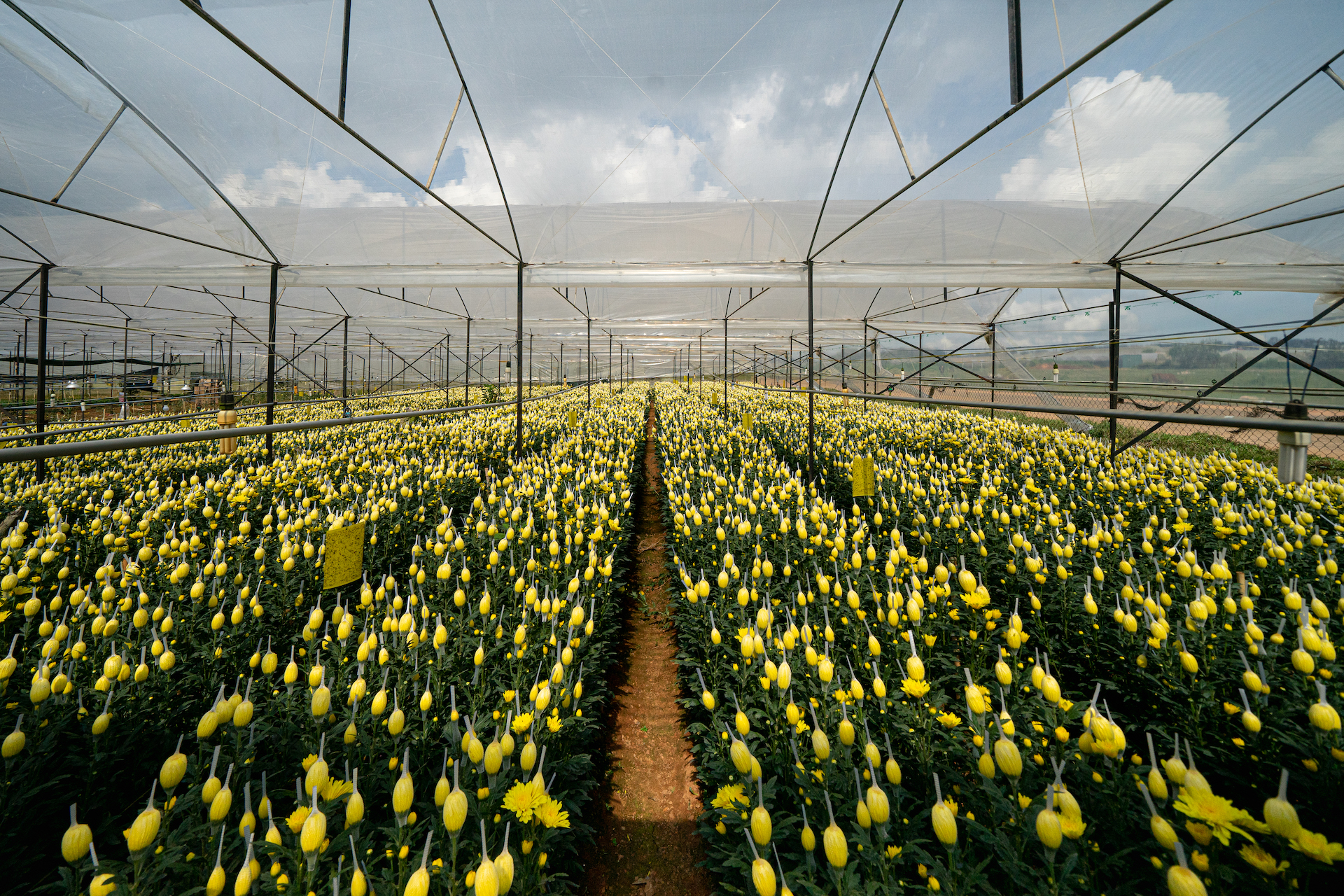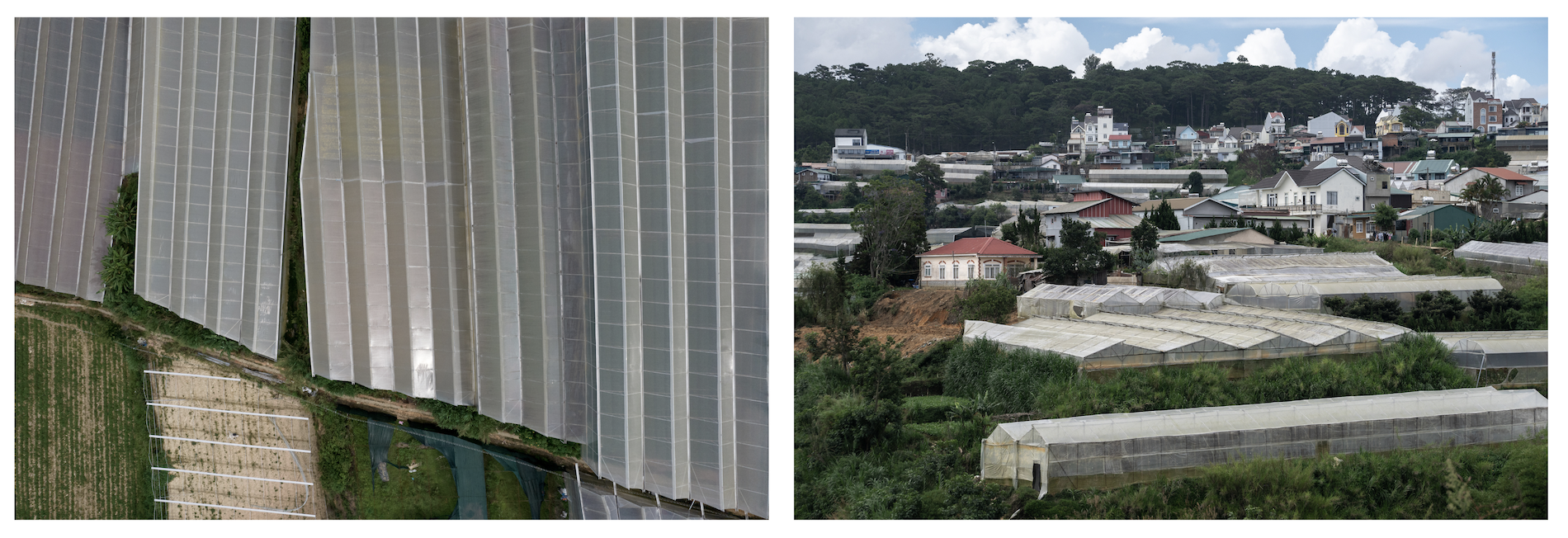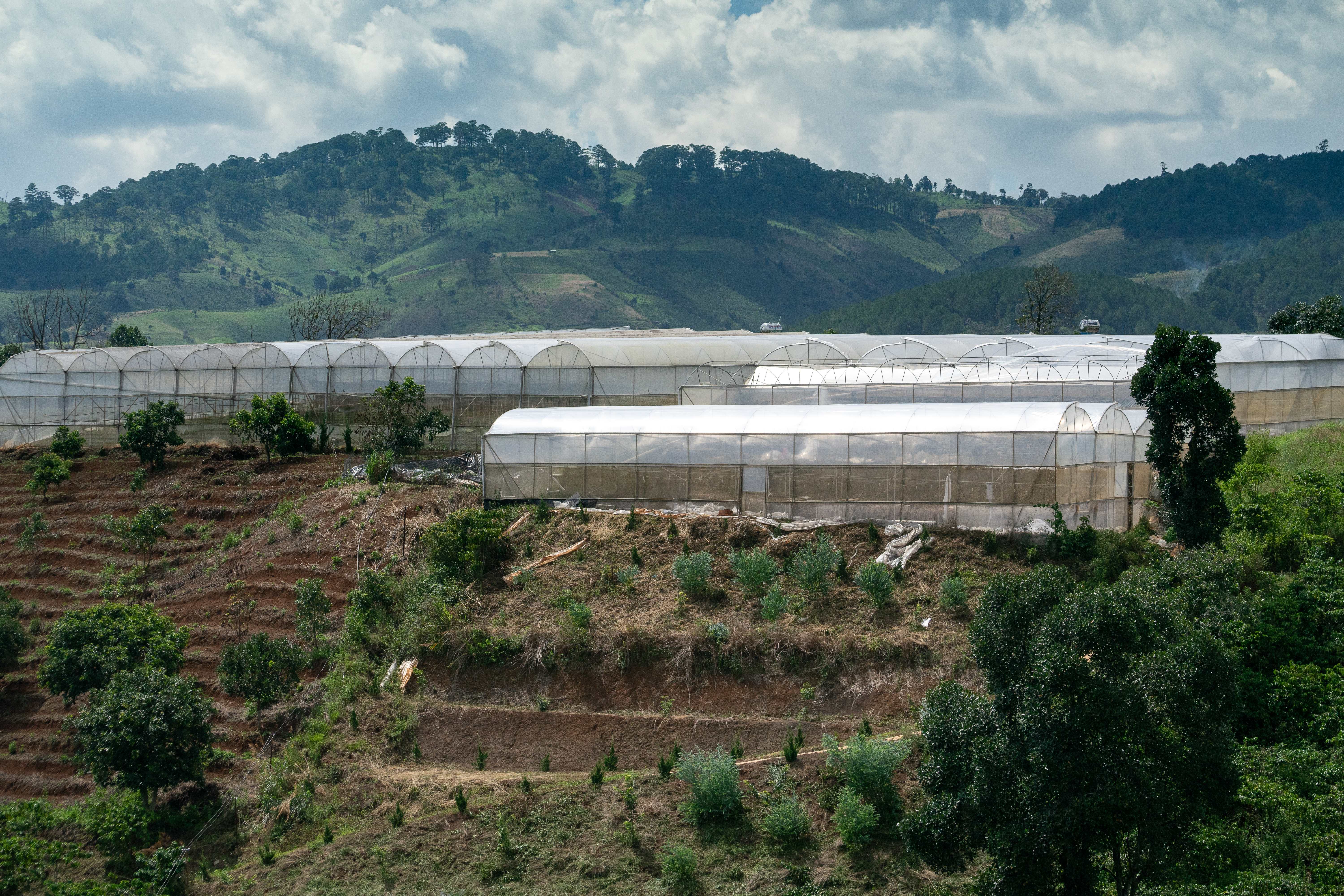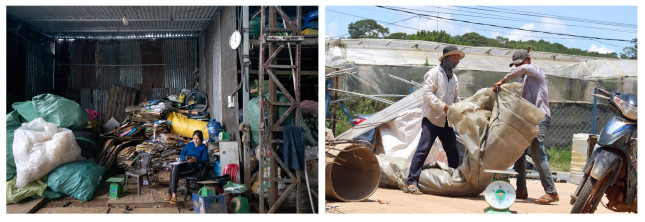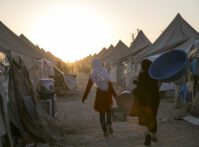-
Greenhouse Plastic Boom Blights Vietnam’s Vegetable Basket
Cam Ly landfill was, until it was shut down in 2020, the primary dumping ground for the city of Dalat. A hilltop locale 5 kilometers from central Dalat, the landfill was the final destination for the majority of plastic used in agriculture in Vietnam’s Central Highlands region. But in August 2019, heavy rain prompted an outpouring of trash, sending plastic sheeting from greenhouses and untreated agrichemical bags and bottles rushing downhill. The incident covered lowland farms in thousands of metric tons of waste. Dalat, known for its temperate climate, rolling hills, pine trees and agriculture, is the capital of Lam Dong Province. Over the past two decades, plastic greenhouses have enveloped much of the landscape within the city and surrounding areas. These sheets of plastic have increased agricultural production and raised farmers’ income. However, greenhouses are also contributing to rising temperatures, floods, pollution of waterways and the build-up of agri-plastic waste in places with no formal system for recycling.
Plastic shield against a volatile climate
While greenhouses are expensive, they are a “mark of achievement” for many farmers, often leading to higher yields and acting as a “safety net against climate change”, says Nguyễn Châu Bảo, co-founder of Act Now, a Dalat-based environmental nonprofit. With increasingly unpredictable weather patterns in the region, greenhouses allow farmers to control the environment and shield crops from harsh conditions. Plastic sheeting allows nonnative plants, like tomatoes, to be grown all year, protected from heavy rains, humidity, hail and frost. Heavy downpours can cause roots to become waterlogged, split tomato skins, and lead to bacterial infections in the plant. For this reason, the majority of tomatoes are grown inside greenhouses in Dalat. Hiền, a farmer in Dalat, says he relies on plastic sheeting to ensure a stable growing environment for his crop of flowers. He rents the land where he has a small greenhouse for six-month periods, so it is vital his crops come to harvest reliably within this time. From Hiền’s roadside flower farm, greenhouses can be seen in every direction.
Hiền, a farmer in Dalat, says he relies on plastic sheeting to ensure a stable growing environment for his crop of flowers. He rents the land where he has a small greenhouse for six-month periods, so it is vital his crops come to harvest reliably within this time. From Hiền’s roadside flower farm, greenhouses can be seen in every direction.

Ecological toll of plastic greenhouses
Despite the benefits for farmers, greenhouses have a heavy ecological impact on the region. Võ Xuân Hạo Khuyên, who was born in Dalat in 1995, used to be able to see wide swaths of pines from her home. The green space has since disappeared. “Right now it is just the white color because all you see is the greenhouses,” she tells The Third Pole. The problems caused by rapid greenhouse development are easy to see, Khuyên adds, listing temperature increases, light pollution, and floods. From 2008 to 2018, temperatures in Dalat increased by between 1 and 1.5 degrees Celsius, and the rise is expected to continue, according to statements in a local news report from Vũ Ngọc Long, former director of the Ho Chi Minh City-based Southern Institute of Ecology. While urban development has played a role in the temperature rise, Long said the immediate area surrounding a greenhouse is three to five degrees hotter than areas in similar climates without plastic-covered structures. While rising temperatures are a concern, floods have already had a severe impact on the region and are now a regular occurrence during the rainy season from May to October.
When raindrops hit a greenhouse, they cannot be absorbed by the soil below. Instead, says Khuyên (who has studied the sustainability problems created by greenhouses), the runoff from the tightly packed greenhouses creates streams that combine after heavy rain, flooding the city’s drainage system.
“We are a mountain city. We aren’t supposed to have floods, but at the end of the day we have floods, very heavy floods that even killed people,” Khuyên says.
While rising temperatures are a concern, floods have already had a severe impact on the region and are now a regular occurrence during the rainy season from May to October.
When raindrops hit a greenhouse, they cannot be absorbed by the soil below. Instead, says Khuyên (who has studied the sustainability problems created by greenhouses), the runoff from the tightly packed greenhouses creates streams that combine after heavy rain, flooding the city’s drainage system.
“We are a mountain city. We aren’t supposed to have floods, but at the end of the day we have floods, very heavy floods that even killed people,” Khuyên says.
 In August 2019, the damage from the severe floods that hit Dalat and surrounding areas extended beyond swamping the land with trash from the landfill. More than 12,000 homes were flooded, 10,000 hectares of crops were damaged and 11 people died. In 2020, 44 people were forced to evacuate a Dalat hotel when the structure became at risk of collapsing during a downpour. That same year, a runner died after being washed away by a flash flood during the Dalat Ultra Trail marathon.
Districts downstream of Dalat along the Cam Ly River – which flows through the city– are also impacted by the greenhouse-amplified flooding. During the 2021 rainy season, areas of Dalat and Duc Trong District, approximately an hour’s drive from the capital city, flooded within 12 hours of heavy rain. Farmland was inundated, households were forced to relocate and sections of a national highway were submerged.
“Floods never used to appear in Dalat,” says Phạm Trọng Phu, who grew up in Lam Dong Province and now works for SNV Netherlands Development Organization, a nonprofit with a base in Dalat. “Many disasters have followed with the development of greenhouses.”
In August 2019, the damage from the severe floods that hit Dalat and surrounding areas extended beyond swamping the land with trash from the landfill. More than 12,000 homes were flooded, 10,000 hectares of crops were damaged and 11 people died. In 2020, 44 people were forced to evacuate a Dalat hotel when the structure became at risk of collapsing during a downpour. That same year, a runner died after being washed away by a flash flood during the Dalat Ultra Trail marathon.
Districts downstream of Dalat along the Cam Ly River – which flows through the city– are also impacted by the greenhouse-amplified flooding. During the 2021 rainy season, areas of Dalat and Duc Trong District, approximately an hour’s drive from the capital city, flooded within 12 hours of heavy rain. Farmland was inundated, households were forced to relocate and sections of a national highway were submerged.
“Floods never used to appear in Dalat,” says Phạm Trọng Phu, who grew up in Lam Dong Province and now works for SNV Netherlands Development Organization, a nonprofit with a base in Dalat. “Many disasters have followed with the development of greenhouses.”
An alternative way to farm?
Les Vergers du Mekong (LVDM) Pilot Organic Farm is located down a steep, dirt road in Dalat’s Ward 3. With funding from LVDM and the GIZ (German development agency), the team of six running the farm can experiment with eco-friendly methods without direct impacts on their livelihoods. Fruit is grown to be juiced and bottled for sale, and the only plastic sheeting to be found is a small covering protecting seedlings. Although many farmers in the region have taken up greenhouse farming because of its stable yields, others believe the environmental toll of the plastic coverings outweighs the benefits.
Nguyễn Nhi is the farm manager at Rừng Thông Mơ Farm & Bistro, a winding 25-minute drive from central Dalat through pines with sections occupied by greenhouses. During the dry season from November to April, Nhi says, heat is trapped inside the greenhouses, causing temperatures in surrounding areas to increase. Additionally, the moist atmosphere inside greenhouses is conducive for worms that eat the vegetables, causing farmers to rely heavily on pesticides.
Rừng Thông Mơ has no plastic greenhouses. Instead, herbs and green leafy vegetables are grown using intercropping methods, and rice husks are burnt to deter pests. The farm produces little to no plastic waste, avoiding the harmful impact agri-plastics can have on soil health.
Although many farmers in the region have taken up greenhouse farming because of its stable yields, others believe the environmental toll of the plastic coverings outweighs the benefits.
Nguyễn Nhi is the farm manager at Rừng Thông Mơ Farm & Bistro, a winding 25-minute drive from central Dalat through pines with sections occupied by greenhouses. During the dry season from November to April, Nhi says, heat is trapped inside the greenhouses, causing temperatures in surrounding areas to increase. Additionally, the moist atmosphere inside greenhouses is conducive for worms that eat the vegetables, causing farmers to rely heavily on pesticides.
Rừng Thông Mơ has no plastic greenhouses. Instead, herbs and green leafy vegetables are grown using intercropping methods, and rice husks are burnt to deter pests. The farm produces little to no plastic waste, avoiding the harmful impact agri-plastics can have on soil health.
 “Of course I want people to use fewer greenhouses but it’s hard because it comes with efficiency. You can make more money,” Nhi says. “It is hard to ask them to go back to the natural way of farming. I expect the number of greenhouses to double.”
“Of course I want people to use fewer greenhouses but it’s hard because it comes with efficiency. You can make more money,” Nhi says. “It is hard to ask them to go back to the natural way of farming. I expect the number of greenhouses to double.”
Plastic waste is not recycled
Over time, due to use and UV exposure, plastic degrades and needs to be replaced. The majority of the plastic sheeting used for greenhouses in Dalat is burnt or buried once it is no longer usable. Nguyễn Hồng Quân, who grew up in Dalat and is now director at the Institute for Circular Economy Development, a research unit within Vietnam National University in Ho Chi Minh City, tells The Third Pole that currently no “holistic or systematic solution” is available to recycle agri-plastics in Lam Dong Province. The majority end up in landfills. “I think this is quite a big issue now. We see a lot of plastic waste from greenhouses,” Quân says, adding that the difficulty of managing plastic sheeting is compounded by farmers being dependent on greenhouses for their livelihoods. Vietnam has no formal system for recycling plastic materials, despite the January 2022 launch of a new environmental protection law. The law includes an unfunded mandate that makes the country’s local governments responsible for sorting and recycling waste.
Miquel Angel sits on Vietnam’s Tourism Advisory Board and surveyed some landfills this April. He has not seen improvements in waste management and says trash is still being buried, burned or allowed to leak into the country’s waterways.
“This is a lot of talk,” he says of the new regulation. “Nobody is taking any action.”
“Greenhouses are like single-use plastic, they should be banned,” says Paul Olivier, who has lived in Dalat for 16 years and supports farmers with transforming waste into feed, fuel and fertilizer. Olivier tells The Third Pole he sees plastic sheeting, styrofoam, and bottles and bags for chemical pesticides and fertilizers in Lam Dong’s streams, lakes and rivers, where fish often float lifeless at the surface.
Informal waste collectors are the driving force behind the management of Vietnam’s plastic waste, approximately 27 percent of which is recycled. Waste pickers gather plastic bottles, cardboard and a variety of other discarded materials to sell at a local vựa phế liệu – a scrap collection center where recyclables can be bought and sold.
Vietnam has no formal system for recycling plastic materials, despite the January 2022 launch of a new environmental protection law. The law includes an unfunded mandate that makes the country’s local governments responsible for sorting and recycling waste.
Miquel Angel sits on Vietnam’s Tourism Advisory Board and surveyed some landfills this April. He has not seen improvements in waste management and says trash is still being buried, burned or allowed to leak into the country’s waterways.
“This is a lot of talk,” he says of the new regulation. “Nobody is taking any action.”
“Greenhouses are like single-use plastic, they should be banned,” says Paul Olivier, who has lived in Dalat for 16 years and supports farmers with transforming waste into feed, fuel and fertilizer. Olivier tells The Third Pole he sees plastic sheeting, styrofoam, and bottles and bags for chemical pesticides and fertilizers in Lam Dong’s streams, lakes and rivers, where fish often float lifeless at the surface.
Informal waste collectors are the driving force behind the management of Vietnam’s plastic waste, approximately 27 percent of which is recycled. Waste pickers gather plastic bottles, cardboard and a variety of other discarded materials to sell at a local vựa phế liệu – a scrap collection center where recyclables can be bought and sold.

Action for change
Although not yet approved, Lam Dong Province’s Department of Agriculture and Rural Development has put forward a scheme for the management of greenhouse farming with specific goals set for 2025 and a vision for 2030. The document acknowledges the province currently has no regulations on the management and construction of greenhouses, and local authorities lack effective solutions to lessen the environmental impacts of greenhouses. The government wishes to control the proportion of greenhouse area in agricultural land to below 40 percent in all of Dalat’s 12 wards. All greenhouses illegally built on forest land, ecologically sensitive areas, and historic, scenic and culturally significant land will be cleared away by 2025. By 2030, the government also wants to upgrade substandard greenhouses, manage greenhouse construction, and build new modern greenhouses in the province. “I really want to look at the positive side,” says Bảo of Act Now. “It has to be a community change, a very big systemic change if you want to see a reduction in plastic waste or agricultural waste. I think it is the biggest problem we need to solve.”
“I really want to look at the positive side,” says Bảo of Act Now. “It has to be a community change, a very big systemic change if you want to see a reduction in plastic waste or agricultural waste. I think it is the biggest problem we need to solve.”
This blog is part of the Wilson Center-East-West Center Vulnerable Deltas project that is diving into climate, plastic waste and development threats to three SE Asian and two Chinese deltas. The project is supported by the Luce Foundation.
This article was translated and posted in the Saigoneer in Vietnamese.
Govi Snell is a reporter for Southeast Asia Globe and freelance journalist based in Ho Chi Minh City. Twitter: @GoviSnell
Thinh Doan (Photographer) is a photographer based in Saigon, mainly snapping aerial and urban photography. Instagram: @itscthinh
Lead Image Credit: In flower-filled plastic greenhouses in Dalat, Vietnam, each bloom is wrapped in a plastic net to maintain its shape. Courtesy of Thinh Doan / The Third Pole.
Sources: China Dialogue, Environmental Science and Pollution Research, Heinrich-Böll-Stiftung, Newsbeezer.com, ReliefWeb, Southeast Asia Globe, Tuoi Tre News, Vietnam times, VnExpress International, World Agroforestry.
 A Publication of the Stimson Center.
A Publication of the Stimson Center.

